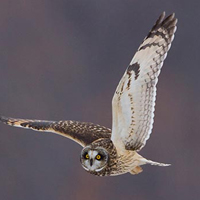Short-eared Owl
Scientific name: Asio flammeus

Photo credit: Marie Read
Status
Threatened
“Threatened” means the species lives in the wild in Ontario, is not endangered, but is likely to become endangered if steps are not taken to address factors threatening it.
Date added to the Species at Risk in Ontario List
The Short-eared Owl was already assessed as at risk when the Endangered Species Act, 2007 took effect in 2008.
Read the most recent assessment report (PDF).
What it looks like
The Short-eared Owl has a large, round head, with small tufts of feathers that look like ears. This medium-sized owl is about 34 to 42 centimetres long, with fairly long wings and a short tail. Adults are cryptically coloured to blend in with their surroundings and have a brown back and creamy-buff chest with brown streaks. Males and females are similar in appearance, but females are slightly larger and tend to be darker.
Its colours give the Short-eared Owl excellent camouflage, so this bird is mostly seen in flight, often at dawn and dusk. It can easily be identified by its irregular flight, which resembles that of a foraging moth – deep wingbeats, occasional hovering, and skimming patches of grassland or marsh.
Where it lives
The Short-eared Owl lives in open areas such as grasslands, marshes and tundra where it nests on the ground and hunts for small mammals, especially voles.
Where it’s been found in Ontario
The Short-eared Owl has a world-wide distribution, and in North America its range extends from the tundra south to northern Mexico. The species is considered to be highly nomadic, moving in response to the abundance of small mammal prey.
In Ontario, the species is widely distributed. The majority of Ontario observations during the breeding season occur in the James Bay and Hudson Bay Lowlands. The species has become an increasingly rare and irregular breeder in southern Ontario, primarily associated with remnant habitat near:
- Kingston
- the lower Ottawa River
- the Niagara Peninsula
- Sault Ste. Marie
Most northern populations are migratory, moving southward in the winter to the Carolinian zone and the Kingston region. Of particular importance are:
- Long Point
- Haldimand County
- Amherst Island
- Wolfe Island
What threatens it
Short-eared Owls are thought to be vulnerable to the effects of various threats in breeding and wintering areas and along their migration routes. Likely threats to the species in Ontario include:
- habitat shifting and alteration
- loss of nesting and wintering habitat to urban expansion
- changes in agricultural crops and intensification
- collisions with vehicles and airplanes
- the accumulation of toxins used for rodent control
Action we are taking
This species and its habitat are protected under Ontario’s Endangered Species Act, 2007 (ESA).
The ESA also requires us to prepare recovery guidance for threatened species such as Short-eared Owl to guide recovery efforts for the species in Ontario.
All species listed on the Species at Risk in Ontario List may be eligible for consideration for government funding through the Species at Risk Stewardship Program.
What you can do
Report a sighting
- Submit your observations of species at risk to the Natural Heritage Information Centre (NHIC), which is Ontario’s conservation data centre. Join the centre’s Rare Species of Ontario project in iNaturalist, an online plant and animal identification app, to quickly and easily submit your observations.
- Birds Canada is working to advance the understanding, appreciation and conservation of wild birds and their habitat in Ontario and elsewhere. For more information on how you can help, visit their website.
Volunteer
Volunteer with your local nature club or provincial park to participate in surveys or stewardship work focused on species at risk.
Be a good steward
Private landowners have a very important role to play in species recovery. If you find species at risk on your land, you may be eligible for stewardship programs that support the protection and recovery of species at risk and their habitats, such as the Species at Risk Stewardship Program.
Report illegal activity
Report any illegal activity related to plants and wildlife to
Quick facts
- This owl hunts day and night, mainly at dawn and dusk in winter. It flies low over open ground and locates prey by ear. It kills prey with a bite to the back of the skull, often swallowing it whole.
- The Short-eared Owl is one of the few species that seems to have benefited from strip-mining. It nests on reclaimed and replanted mines that have been transformed into open areas with vegetation south of its normal breeding range.
- The Short-eared Owl may compete with the nationally and provincially at-risk Barn Owl (Tyto alba) in some areas. Some successful nest box programs to attract Barn Owls have coincided with the decline of the Short-eared Owl in the same area.
- Short-eared Owls are nomadic, meaning that individuals wander over large distances, usually settling in areas where prey densities are high.
- The scientific name for Short-eared Owl, Asio flammeus, is Latin for “horned owl” (Asio) and “fiery” or “flaming” (flammeus), referring to its plumage.
- There are 10 subspecies of Short-eared Owl, which can be found on every continent, except Antarctica and Australia.